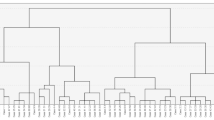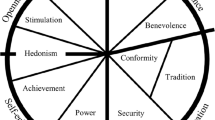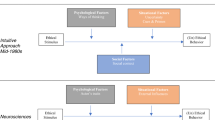Abstract
The paper aims to study relationships between results obtained by two instruments, the rational-experiential inventory, in its modified version named REI-20, and the general decision-making style (GDMS). Although both instruments differ in concept and construction of decision styles, they refer to two very similar constructs—rationality and experientiality or intuition, resulting from the dual concept of cognitive-experiential self-theory. Using the same experimental sample, we examined the relationships between the REI-20 modes, i.e., rational and experiential, and GDMS modes, i.e., rational, intuitive, dependent, avoidant, and spontaneous. We checked how rational and experiential decision-making styles identified by REI-20 correspond to the rational and intuitive modes of GDMS. We also examined the relationships between clusters of decision-making profiles, defined as combinations of various levels of rational and intuitive/experiential modes determined from both instruments. Finally, we analyzed the gender differences between the styles identified by both inventories. The between-tool analysis showed that rationality determined from REI-20 and GDMS correlate only weakly; however, the correlation between experientiality and intuitiveness is strong. Both tools produced inconclusive results when comparing gender differences. REI-20 differentiated significantly between genders, indicating that women are less rational and more experimental than men, while GDMS considered these differences insignificant. It implies that using a particular decision-making style inventory in advanced analyses of the process and outcomes of the decision-making requires exceptional caution as various tools may produce a different classification of decision-makers and lead to different, if not contradictory, conclusions.

Source: Own study

Source: Own study

Source: Own study
Similar content being viewed by others
References
Akinci C, Sadler-Smith E (2013) Assessing individual differences in experiential (intuitive) and rational (analytical) cognitive styles. Int J Sel Assess 21(2):211–221
Alacreu-Crespo A, Fuentes MC, Abad-Tortosa D, Cano-Lopez I, González E, Serrano MÁ (2019) Spanish validation of general decision-making style scale: sex invariance, sex differences and relationships with personality and coping styles. Judgm Decis Mak 14(6):739
Allinson CW, Hayes J (1996) The cognitive style index: a measure of intuition-analysis for organizational research. J Manag Stud 33(1):119–135
Appelt KC, Milch KF, Handgraaf MJJ, Weber EU (2011) The decision making individual differences inventory and guidelines for the study of individual differences in judgment and decision-making research. Judgm Decis Mak 6(3):11
Armstrong SJ, Cools E, Sadler-Smith E (2012) Role of cognitive styles in business and management: reviewing 40 years of research. Int J Manag Rev 14(3):238–262
Ayal S, Hochman G, Zakay D (2011) Two sides of the same coin: information processing style and reverse biases. Judgm Decis Mak 6(4):295
Ayal S, Rusou Z, Zakay D, Hochman G (2015) Determinants of judgment and decision making quality: the interplay between information processing style and situational factors. Front Psychol. https://doi.org/10.3389/fpsyg.2015.01088
Baiocco R, Laghi F (2009) Decision-making style among adolescents: relationship with sensation seeking and locus of control. J Adolesc 32:963–976
Bavolar J, Orosová O (2015) Decision-making styles and their associations with decision-making competencies and mental health. Judgm Decis Mak 10(1):115–122
Bentler PM, Bonett DG (1980) Significance tests and goodness of fit in the analysis of covariance structures. Psychol Bull 88(3):588
Berisha G, Pula JS, Krasniqi B (2018) Convergent validity of two decision making style measures. J Dyn Decis Making 4:1–3
Björklund F, Bäckström M (2008) Individual differences in processing styles: validity of the rational-experiential inventory. Scand J Psychol 49(5):439–446
Briggs KC, Myers IB (1977) The Myers–Briggs type indicator: form G. Consulting Psychologists Press
Browne MW, Cudeck R (1992) Alternative ways of assessing model fit. Sociol Methods Res 21(2):230–258
Buzdar MA, Ali A, Tariq RUH (2015) Religious orientations as a predictor of rational thinking among secondary school students. Think Skills Creativity 16:1–8. https://doi.org/10.1016/j.tsc.2014.11.005
Cacioppo JT, Petty RE (1982) The need for cognition. J Pers Soc Psychol 42(1):116
Carelli MG, Wiberg B, Wiberg M (2011) Development and construct validation of the Swedish Zimbardo time perspective inventory. Eur J Psychol Assess
Curşeu PL, Schruijer S (2012) Decision styles and rationality: an analysis of the predictive validity of the general decision-making style inventory. Educ Psychol Meas 72(6):1053–1062. https://doi.org/10.1177/0013164412448066
de Acedo Lizárraga MLS, de Acedo Baquedano MTS, Cardelle-Elawar M (2007) Factors that affect decision making: gender and age differences. Int J Psychol Psychol Ther 7(3):381–391
del Campo C, Pauser S, Steiner E, Vetschera R (2016) Decision making styles and the use of heuristics in decision making. J Bus Econ 86(4):389–412. https://doi.org/10.1007/s11573-016-0811-y
Delaney R, Strough J, Parker AM, de Bruin WB (2015) Variations in decision-making profiles by age and gender: a cluster-analytic approach. Personal Individ Differ 85:19–24
Engin A (2021) The cognitive ability and working memory framework: interpreting cognitive reflection test results in the domain of the cognitive experiential theory. CEJOR 29(1):227–245. https://doi.org/10.1007/s10100-020-00721-6
Epstein S (2003) Cognitive-experiential self-theory of personality. In: Millon T, Lerner MJ (eds) Handbook of psychology. Wiley, pp 159–184
Epstein S, Meier P (1989) Constructive thinking: a broad coping variable with specific components. J Pers Soc Psychol 57(2):332
Epstein S, Pacini R, Denes-Raj V, Heier H (1995) Individual differences in heuristic processing. Unpublished manuscript. University of Massachusetts
Epstein S, Pacini R, Denes-Raj V, Heier H (1996) Individual differences in intuitive–experiential and analytical–rational thinking styles. J Pers Soc Psychol 71(2):390
Fischer S, Soyez K, Gurtner S (2015) Adapting Scott and Bruce’s general decision-making style inventory to patient decision making in provider choice. Med Decis Mak. https://doi.org/10.1177/0272989X15575518
Galotti KM, Ciner E, Altenbaumer HE, Geerts HJ, Rupp A, Woulfe J (2006) Decision-making styles in a real-life decision: choosing a college major. Personal Individ Differ 41(4):629–639
Gambetti E, Fabbri M, Bensi L, Tonetti L (2008) A contribution to the Italian validation of the general decision-making style inventory. Personal Individ Differ 44(4):842–852
George D, Mallery P (2010) SPSS for windows step by step. A simple study guide and reference (10. Baskı). GEN, Pearson Education, Inc, Boston
Girard AJ, Reeve CL, Bonaccio S (2016) Assessing decision-making style in French-speaking populations: translation and validation of the general decision-making style questionnaire. Eur Rev Appl Psychol 66(6):325–333
Handley SJ, Newstead SE, Wright H (2000) Rational and experiential thinking: a study of the REI. In: Riding RJ, Rayner SG (eds) International perspectives on individual differences, vol 1. Ablex Stamford, pp 97–113
Hayes J, Allinson CW, Armstrong SJ (2004) Intuition, women managers and gendered stereotypes. Pers Rev 33(4):403–417. https://doi.org/10.1108/00483480410539489
Hodgkinson GP, Clarke I (2007) Conceptual note: exploring the cognitive significance of organizational strategizing: a dual-process framework and research agenda. Hum Relat 60(1):243–255
Hodgkinson GP, Sadler-Smith E (2003) Complex or unitary? A critique and empirical re-assessment of the Allinson-Hayes cognitive style index. J Occup Organ Psychol 76(2):243–268. https://doi.org/10.1348/096317903765913722
Howard MC (2016) A review of exploratory factor analysis decisions and overview of current practices: What we are doing and how can we improve? Int J Hum-Comput Interact 32(1):51–62
Hu L, Bentler PM (1999) Cutoff criteria for fit indexes in covariance structure analysis: conventional criteria versus new alternatives. Struct Equ Model 6(1):1–55
Kersten GE, Roszkowska E, Wachowicz T (2022) How well agents represent their principals’ preferences: the effect of information processing, value orientation, and goals. In: Szapiro T, Kacprzyk J (eds) Collective decisions: theory, algorithms and decision support systems. Springer, pp 119–151. https://doi.org/10.1007/978-3-030-84997-9_6
Kline RB (2015) Principles and practice of structural equation modeling. Guilford Publications
Kozhevnikov M (2007) Cognitive styles in the context of modern psychology: toward an integrated framework of cognitive style. Psychol Bull 133(3):464
Loo R (2000) A psychometric evaluation of the general decision-making style inventory. Personal Individ Differ 29(5):895–905. https://doi.org/10.1016/S0191-8869(99)00241-X
Marks AD, Hine DW, Blore RL, Phillips WJ (2008) Assessing individual differences in adolescents’ preference for rational and experiential cognition. Personal Individ Differ 44(1):42–52
Marsh HW, Hau K-T (1996) Assessing goodness of fit: Is parsimony always desirable? J Exp Educ 64(4):364–390
Mehta R (2020) Gender-based differences in consumer decision-making styles: implications for marketers. Decision 47(3):319–329. https://doi.org/10.1007/s40622-020-00252-8
Monacis L, de Palo V, Di Nuovo S, Sinatra M (2016) Validation of the rational and experiential multimodal inventory in the Italian context. Psychol Rep 119(1):242–262
Norris P, Pacini R, Epstein S (1998) The Rational-Experiential Inventory, short form. Unpublished inventory. University of Massachusetts, Amherst
Novak TP, Hoffman DL (2009) The fit of thinking style and situation: new measures of situation-specific experiential and rational cognition. J Consum Res 36(1):56–72. https://doi.org/10.1086/596026
Öngen DE (2012) Adaptation of the general decision making style inventory into the Turkish culture. VI International Turkish Culture, Arts and Cultural HeritageSymposjum, Milan
Orçan F (2018) Exploratory and confirmatory factor analysis: Which one to use first? J Meas Eval Educ Psychol 9(4):414–421
Pacini R, Epstein S (1999) The relation of rational and experiential information processing styles to personality, basic beliefs, and the ratio-bias phenomenon. J Pers Soc Psychol 76(6):972
Paulhus DL (1986) Self-deception and impression management in test responses. In: Angleitner A, Wiggins JS (eds) Personality assessment via questionnaires: current issues in theory and measurement. Springer, pp 143–165. https://doi.org/10.1007/978-3-642-70751-3_8
Pretz JE (2008) Intuition versus analysis: strategy and experience in complex everyday problem solving. Mem Cognit 36(3):554–566. https://doi.org/10.3758/MC.36.3.554
Reimer RA (2009) Health risk cognitions: an empirical examination of the effects of heuristic versus reasoned information processing [Iowa State University]. Graduate Theses and Dissertations. Paper 10566
Reyna C, Ortiz MV (2016) Psychometric study of the rational experiential inventory among undergraduate argentinean students. Rev de Psicol 34(2):337–355
Roszkowska E, Wachowicz T (2019) Cognitive style and the expectations towards the preference representation in decision support systems. In: Group decision and negotiation: behavior, models, and support. Springer, Cham, pp 163–177. https://doi.org/10.1007/978-3-030-21711-2_13
Sadler-Smith E (2002) The role of cognitive style in management education. Acad Manag Proc 2002(1):C1–C6
Sadler-Smith E (2011) The intuitive style: Relationships with local/global and verbal/visual styles, gender, and superstitious reasoning. Learn Individ Differ 21(3):263–270
Sagiv L, Arieli S, Goldenberg J, Goldschmidt A (2010) Structure and freedom in creativity: the interplay between externally imposed structure and personal cognitive style. J Organ Behav 31(8):1086–1110
Salo I, Allwood CM (2011) Decision-making styles, stress and gender among investigators. Poli Int J Police Strateg Manag
Sánchez E, Fernández-Berrocal P, Alonso D, Tubau E (2012) Measuring both systems of reasoning: a study of the predictive capacity of a new version of the rational-experiential inventory. Eur J Educ Psychol 5(2)
Scott SG, Bruce RA (1995) Decision-making style: the development and assessment of a new measure. Educ Psychol Measur 55(5):818–831
Shiloh S, Salton E, Sharabi D (2002) Individual differences in rational and intuitive thinking styles as predictors of heuristic responses and framing effects. Personal Individ Differ 32(3):415–429
Shirzadifard M, Shahghasemi E, Hejazi E, Naghsh Z, Ranjbar G (2018) Psychometric properties of rational-experiential inventory for adolescents. SAGE Open 8(1):2158244018767219
Sladek RM, Bond MJ, Phillips PA (2010) Age and gender differences in preferences for rational and experiential thinking. Personal Individ Differ 49(8):907–911
Spicer DP, Sadler-Smith E (2005) An examination of the general decision making style questionnaire in two UK samples. J Manag Psychol 20(2):137–149. https://doi.org/10.1108/02683940510579777
Stanovich KE, West RF, Toplak ME (2016) The rationality quotient: toward a test of rational thinking. MIT Press
Steiger JH (1990) Structural model evaluation and modification: an interval estimation approach. Multivar Behav Res 25(2):173–180
Thoma V, White E, Panigrahi A, Strowger V, Anderson I (2015) Good thinking or gut feeling? Cognitive reflection and intuition in traders, bankers and financial non-experts. PLoS ONE 10(4):e0123202
Thunholm P (2004) Decision-making style: Habit, style or both? Personal Individ Differ 36(4):931–944. https://doi.org/10.1016/S0191-8869(03)00162-4
Wachowicz T, Roszkowska E (2021a) Can holistic declaration of preferences improve a negotiation offer scoring system? Eur J Oper Res. https://doi.org/10.1016/j.ejor.2021.10.008
Wachowicz T, Roszkowska E (2021b) Holistic preferences and prenegotiation preparation. In: Kilgour DM, Eden C (eds) Handbook of group decision and negotiation. Springer, pp 255–289. https://doi.org/10.1007/978-3-030-12051-1_64-1
Wachowicz T, Roszkowska E, Filipowicz-Chomko M (2019) Decision making profile and the choices of preference elicitation mode—a case of using GDMS inventory. In Zadnik Strim L, Kljajić Borštar M, Žerovnik J, Povh J, Drobne S (Eds) Proceedings of the 15th international symposium on operational reaseach SOR’19. Slovenian Society INFORMATIKA (SDI), pp 72–78
Wang Y, Highhouse S, Lake CJ, Petersen NL, Rada TB (2017) Meta-analytic investigations of the relation between intuition and analysis. J Behav Decis Mak 30(1):15–25
Witteman C, van den Bercken J, Claes L, Godoy A (2009) Assessing rational and intuitive thinking styles. Eur J Psychol Assess 25(1):39–47
Worthington RL, Whittaker TA (2006) Scale development research: a content analysis and recommendations for best practices. Couns Psychol 34(6):806–838
Acknowledgements
This research was funded by grants from Bialystok University of Technology (WZ/WI-IIT/2/2022) and the University of Economics in Katowice.
Funding
No funding available for the study.
Author information
Authors and Affiliations
Corresponding author
Ethics declarations
Conflict of interest
All authors declare that they have no conflict of interest.
Additional information
Publisher's Note
Springer Nature remains neutral with regard to jurisdictional claims in published maps and institutional affiliations.
Rights and permissions
Springer Nature or its licensor (e.g. a society or other partner) holds exclusive rights to this article under a publishing agreement with the author(s) or other rightsholder(s); author self-archiving of the accepted manuscript version of this article is solely governed by the terms of such publishing agreement and applicable law.
About this article
Cite this article
Wachowicz, T., Roszkowska, E. & Filipowicz-Chomko, M. Identifying decision-making style: Do REI-20 and GDMS measure the same?. Decision 50, 415–437 (2023). https://doi.org/10.1007/s40622-024-00373-4
Accepted:
Published:
Issue Date:
DOI: https://doi.org/10.1007/s40622-024-00373-4
Keywords
- Decision-making style
- Decision profile
- Gender
- Rational-experiential inventory
- General decision-making style




